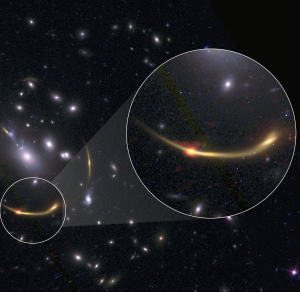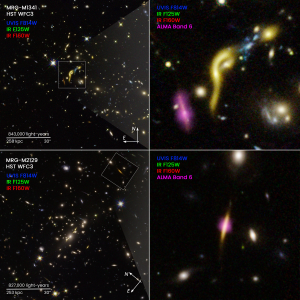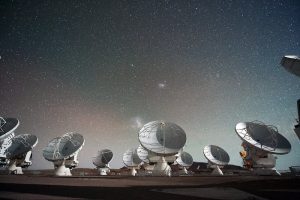
A composite image from NASA’s Hubble Space Telescope and the Atacama Large Millimeter/submillimeter Array (ALMA).
“Live fast, die young” could be the motto of six early, massive, “dead” galaxies that ran out of the cold hydrogen gas needed to make stars early in the life of the Universe. These galaxies lived fast and furious lives, creating their stars in a remarkably short time. But then they literally ran out of gas and shut down star formation. Without more fuel to create stars, these galaxies were running on empty. Why this happened at such early times is a mystery.
NASA’s Hubble Space Telescope, together with the Atacama Large Millimeter/submillimeter Array (ALMA) in northern Chile, found these odd galaxies while looking back billions of years to the peak of star birth in the universe. To locate the very distant galaxies, scientists combined the power of Hubble and ALMA with extremely massive foreground galaxy clusters acting as natural telescopes. Through a phenomenon called strong gravitational lensing, the immense gravity of a giant galaxy cluster warps space, bending and magnifying light from background objects. When an early, massive and very distant galaxy is positioned behind such a cluster, it appears greatly stretched and magnified, allowing astronomers to study details that would otherwise be impossible to see.
When the Universe was about 3 billion years old, just 20% of its current age, it experienced the most prolific period of star birth in its history. But when NASA’s Hubble Space Telescope and the Atacama Large Millimeter/submillimeter Array (ALMA) in northern Chile gazed toward cosmic objects in this period, they found something odd: six early, massive, “dead” galaxies that had run out of the cold hydrogen gas needed to make stars.

These images are composites from NASA’s Hubble Space Telescope and the Atacama Large Millimeter/ submillimeter Array (ALMA). Even with ALMA’s sensitivity, scientists do not detect dust in most of the six galaxies sampled, such as in MRG-M1341, at upper right. An example of the detection of cold dust ALMA did make is galaxy MRG-M2129 at bottom right, which has dust and gas in the very centre.
Without more fuel for star formation, these galaxies were literally running on empty. The findings are published in the journal Nature.
“During an era when the universe had stepped on the gas and reached the peak of star formation activity, these galaxies had already hit the brakes and stopped forming stars,” explains Lamiya Mowla, Postdoctoral Fellow at the Dunlap Institute and author on the paper, “This is because they had run out of the cold gas required for star formation. But how this happened so early on remains a mystery.”
This study is a classic example of the harmony between Hubble and ALMA observations. Hubble pinpointed where in the galaxies the stars exist, showing where they formed in the past. By detecting the cold dust that serves as a proxy for the cold hydrogen gas, ALMA showed astronomers where stars could form in the future if enough fuel were present.
Using Nature’s Own Telescopes
The study of these early, distant, dead galaxies was part of the appropriately named REQUIEM program, which stands for Resolving QUIEscent Magnified Galaxies At High Redshift. (Redshift happens when light is stretched by the expansion of space and appears shifted toward the red part of the spectrum. The farther away a galaxy is with respect to the observer, the redder it appears.)
The REQUIEM team uses extremely massive foreground galaxy clusters as natural telescopes. The immense gravity of a galaxy cluster warps space, bending and magnifying light from background objects. When an early, massive and very distant galaxy is positioned behind such a cluster, it appears greatly stretched and magnified, allowing astronomers to study details that would otherwise be impossible to see. This is called “strong gravitational lensing.”
Only by combining the exquisite resolution of Hubble and ALMA with this strong lensing was the REQUIEM team able to understand the formation of these six galaxies, which appear as they did only a few billion years after the big bang.
“By using strong gravitational lensing as a natural telescope, we can find the distant, most massive and first galaxies to shut down their star formation,” explains the paper’s lead author Kate Whitaker, Assistant Professor of astronomy at the University of Massachusetts, Amherst. Whitaker is also associate faculty at the Cosmic Dawn Center in Copenhagen, Denmark. “I like to think about it like doing science of the 2030s or 40s—with powerful next-generation space telescopes—but today instead by combining the capabilities of Hubble and ALMA, which are boosted by strong lensing.”
In the future, the next generation of extremely large telescopes will provide sharp views of distant galaxies, allowing humans to peer back at billions of light-years of the universe’s history, and discover even more galactic mysteries – as well as some answers, says co-author Allison Man, Assistant Professor in the department of physics and astronomy at the University of British Columbia and former Dunlap Fellow. “The sharp views of distant galaxies will enable a better characterization of their structure – do they have spiral arms or bulges, are they made of clumps or merge frequently with other galaxies? This is invaluable information to discern between different galaxy formation models.”
Live Fast, Die Young

Antennas of the Atacama Large Millimeter/submillimeter Array (ALMA), on the Chajnantor Plateau in the Chilean Andes. Credit: ESO.
These sorts of dead galaxies don’t appear to rejuvenate, even through later minor mergers and accretions of nearby, small galaxies and gas. Gobbling up things around them mostly just “puffs up” the galaxies. If star formation does turn back on, Whitaker described it as “a kind of a frosting.” About 11 billion years later in the present-day universe, these formerly compact galaxies are thought to have evolved to be larger but are still dead in terms of any new star formation.
These six galaxies lived fast and furious lives, creating their stars in a remarkably short time. Why they shut down star formation so early is still a puzzle.
Whitaker proposes several possible explanations: “Did a supermassive black hole in the galaxy’s center turn on and heat up all the gas? If so, the gas could still be there, but now it’s hot. Or it could have been expelled and now it’s being prevented from accreting back onto the galaxy. Or did the galaxy just use it all up, and the supply is cut off? These are some of the open questions that we’ll continue to explore with new observations down the road.”
“The Canadian NIRISS Unbiased Cluster Survey (CANUCS) with the upcoming James Webb Space Telescope will be able to take advantage of both the strong-lensing by galaxy clusters and the increased sensitivity and resolution of JWST,” adds Mowla. “We can explore smaller galaxies at an earlier era to figure out what makes some galaxies hit the brakes even before the Universe enters the fast lane for star formation.”
CREDITS:
RELEASE: NASA, ESA, Ann Jenkins (STScI), Ray Villard (STScI)
MEDIA CONTACT:
Ann Jenkins
Space Telescope Science Institute, Baltimore, Maryland
Ray Villard
Space Telescope Science Institute, Baltimore, Maryland
SCIENCE CONTACT:
Katherine E. Whitaker
University of Massachusetts, Amherst, Massachusetts
The Hubble Space Telescope is a project of international cooperation between NASA and ESA (European Space Agency). NASA’s Goddard Space Flight Center in Greenbelt, Maryland, manages the telescope. The Space Telescope Science Institute (STScI) in Baltimore, Maryland, conducts Hubble science operations. STScI is operated for NASA by the Association of Universities for Research in Astronomy, in Washington, D.C. For more information, visit https://niriss.github.io.
______________________________________________________________________________________
For more information, please contact:
Meaghan MacSween
Communications and Multimedia Officer
Dunlap Institute for Astronomy & Astrophysics,
University of Toronto
meaghan.macsween@utoronto.ca
The Dunlap Institute for Astronomy & Astrophysics at the University of Toronto is an endowed research institute with more than 90 faculty, postdocs, students and staff, dedicated to innovative technology, ground-breaking research, world-class training, and public engagement. The research themes of its faculty and Dunlap Fellows span the Universe and include: optical, infrared and radio instrumentation; Dark Energy; large-scale structure; the Cosmic Microwave Background; the interstellar medium; galaxy evolution; cosmic magnetism; and time-domain science. The Dunlap Institute for Astronomy and Astrophysics, David A. Department of Astronomy & Astrophysics and the Canadian Institute for Theoretical Astrophysics comprise the leading centre for astronomical research in Canada, at the leading research university in the country, the University of Toronto.
